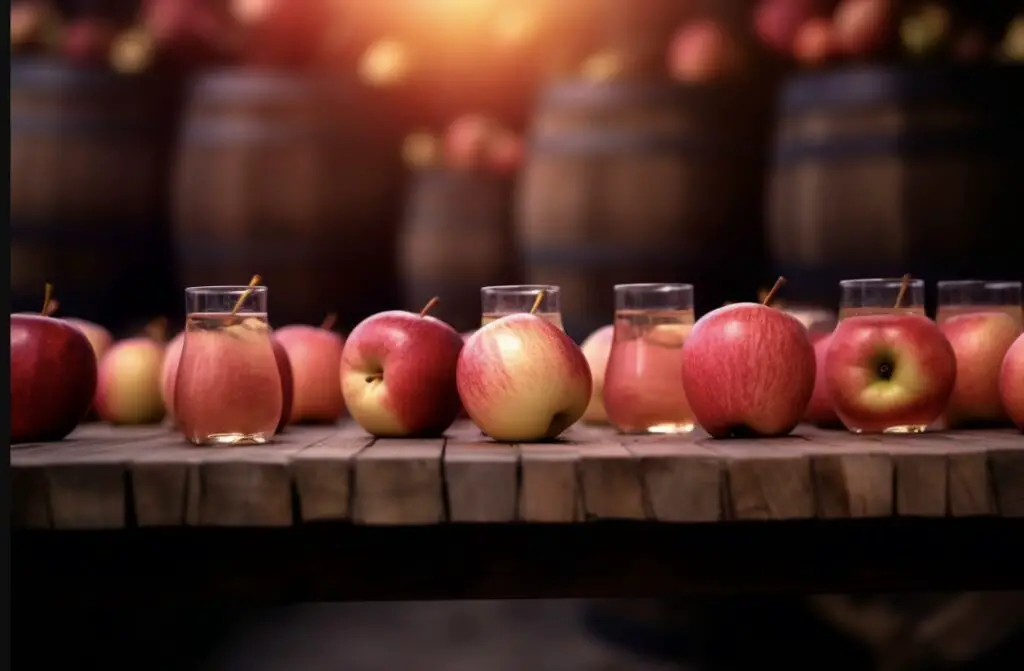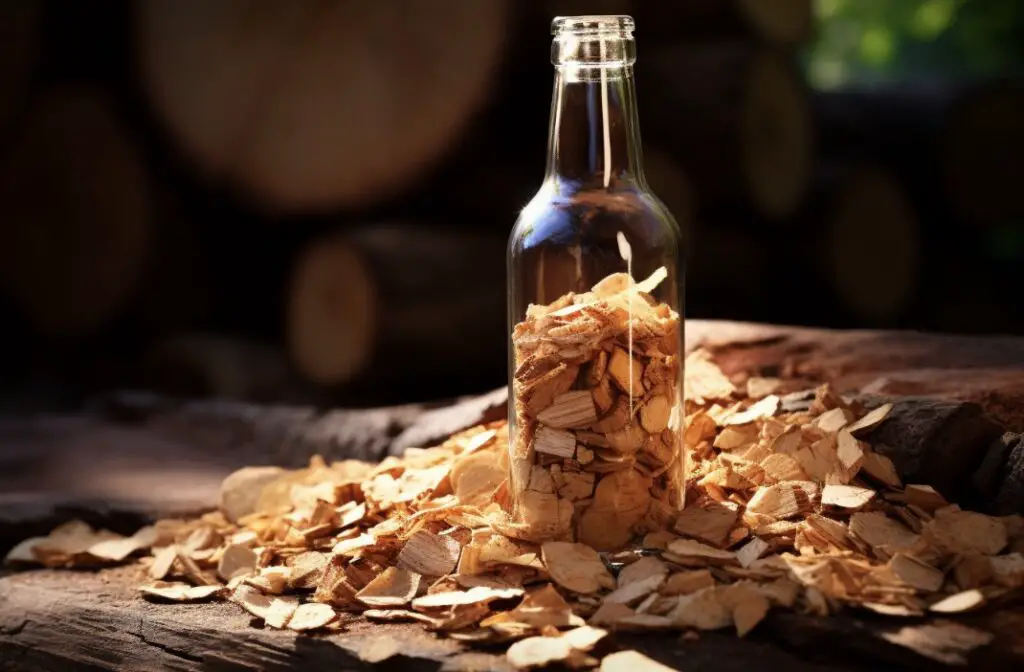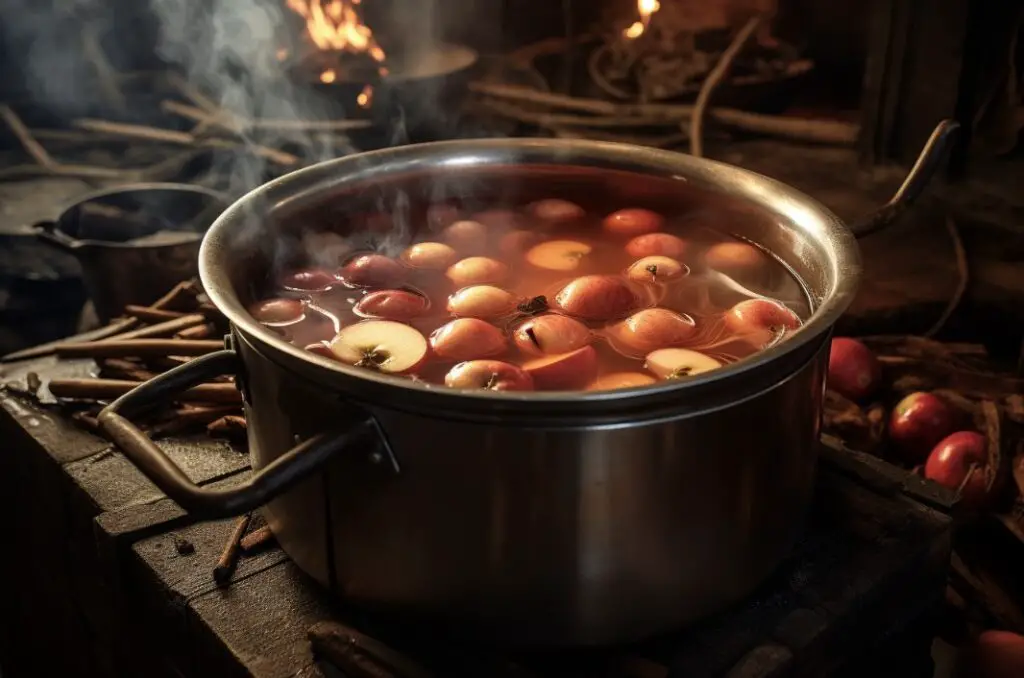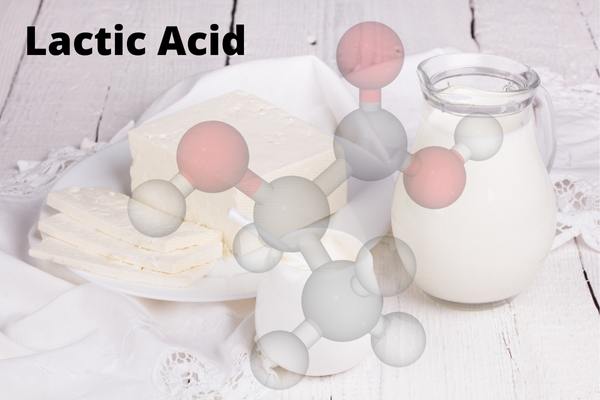If you’ve ever taken a sip of cider and felt that mouth-puckering sensation dance across your tongue, you’ve experienced the magic of tannins.
These natural compounds play an essential role in creating delectable ciders with depth, complexity, and balance.
In this comprehensive guide to tannins in cider brewing, we’ll dive into their sources, functions, types and techniques to achieve the perfect harmony between sweetness, acidity and astringency for your homemade hard cider.
Tannins in cider – take home facts:
- Tannins play a crucial role in creating depth, complexity, and balance in cider brewing.
- Different sources of tannins, including real cider apples, grape skins, black tea, oak barrels or chips and spices can be used to produce unique flavor profiles.
- It is important to calculate the right amount of tannin needed for the desired level of astringency or mouthfeel while avoiding over-tanning that results in unpleasant bitterness.
- Maceration is a method used in cider brewing to extract more color and tannins from the apples before pressing.
- Timing and methods of extraction are also critical factors when adding tannins to hard cider recipes.
Understanding Tannins In Cider Brewing
Tannins play a crucial role in cider making by contributing to the color, astringency, and mouthfeel of the final product, sourced from different fruits, spices, and oak barrels.
Tannins are naturally occurring compounds found in various sources, including the skins and seeds of fruits like apples, which are used in cider brewing.
Tannins contribute to the flavor, mouthfeel, and stability of cider. They provide astringency, bitterness, and complexity to the final product.
In cider brewing, tannins are extracted from apple skins and contribute to the cider’s overall character. The amount of tannin extracted can vary depending on the apple varieties used and the cidermaking techniques employed. Some apple varieties are naturally higher in tannins, while others have lower tannin content.
Tannins in cider serve several purposes. Firstly, they contribute to the mouthfeel by adding a drying and puckering sensation, similar to what is experienced when drinking red wine. This astringency can balance the sweetness of the cider and provide a more rounded flavor profile.

Secondly, tannins play a role in cider’s stability. They help bind proteins and other compounds, reducing the likelihood of haze formation and improving the cider’s clarity and appearance.
To manage tannin levels in cider, cidermakers can adjust their cidermaking process. This can include carefully selecting apple varieties with desired tannin levels, adjusting pressing techniques to control the amount of tannin extracted from apple skins, or blending different apple varieties to achieve the desired tannin profile.
Additionally, some cidermakers may choose to add external sources of tannins during the cidermaking process. This can involve using additives like tannin powders or steeping tannin-rich materials such as oak chips or tea leaves in the cider. These external tannin additions allow for more control over the tannin levels and the resulting flavor profile of the cider.
Overall, tannins play a significant role in cider brewing by contributing to flavor, mouthfeel, and stability. Cidermakers carefully manage tannin levels to create balanced and enjoyable ciders with the desired characteristics.
Definition And Function of Tannins
Tannins are essential compounds in cider making, responsible for the astringent and mouth-puckering sensations experienced when you sip on a quality hard cider.
These natural plant substances, mainly found in apple skins, seeds, and tree bark, play a crucial role in defining the textural qualities of your final brew.

In addition to providing complexity and depth to ciders through their bitterness and astringency, tannins also act as antioxidants that can help protect against oxidative spoilage during fermentation.
For example, bittersweet apples like Dabinett or Kingston Black contain high levels of both sugar content and tannin concentration which work together to create rich-tasting traditional ciders with pronounced sensory characteristics.
Role In Cider Color, Astringency And Mouthfeel
Tannins play a crucial role in the color, astringency, and mouthfeel of cider. Tannins give ciders their characteristic amber hue by interacting with pigment compounds found in apples.

Additionally, tannin molecules interact with proteins in saliva to create an astringent sensation on the tongue that balances out sweetness. The amount of tannin added can also influence the body of cider by creating a fuller mouthfeel that gives it more weight and complexity.
Types Of Tannins in Cider
There are different types of tannins for cider brewing, including hydrolysable and condensed tannins, as well as fruit-based, spice-derived, and oak-derived tannins.
Hydrolysable Tannins
Hydrolysable tannins are a type of tannin that is often found in tree bark, leaves, and certain fruits such as pomegranates and persimmons.
They are also commonly used in the cider-making process to add complexity and balance to the finished product. Unlike condensed tannins, which contribute to mouthfeel and bitterness in cider, hydrolysable tannins have a more subtle effect on flavor and aroma.
In addition, they can help stabilize the color of cider by forming chemical bonds with other compounds present during fermentation. When adding hydrolysable tannins to homemade hard cider, it’s important to remember that too much can overpower other flavors or cause unwanted off-flavors like oxidation or bitterness.
Condensed Tannins
Condensed tannins are different from hydrolysable tannins, as they do not break down easily during the cider-making process. These types of tannins usually come from oak barrels and can add complexity and richness to hard cider.

They also contribute to the color of the finished product, giving it a darker hue. Condensed tannins have a less harsh taste than other types of tannin, making them a popular choice for those who want to balance out their cider’s flavor without overpowering it.
Some common examples of condensed tannin sources include grape skins, tea leaves, and tree barks like fir or pine.
Fruit-based Tannins
Fruit-based tannins are naturally occurring compounds found in various fruits, including grapes, berries, and apples. These tannins add complexity and depth to ciders by contributing unique flavors, aromas, and astringency.
Tart apple varieties like Granny Smith contain higher levels of fruit-based tannins than sweeter varieties like Red Delicious.

Adding fruit to cider is an excellent way to incorporate natural sources of tannins while also enhancing the overall flavor profile. Experimentation with different fruits can lead to unique combinations that appeal to individual tastes and preferences.
Spice-derived Tannins
Spice-derived tannins are another option for adding complexity to your cider’s flavor profile. Spices like cinnamon, allspice, and nutmeg naturally contain tannins that can add a subtle layer of depth to your hard cider.
Adding spice-derived tannins to your cider is fairly easy – simply infuse the spices into your unfermented juice before fermentation begins.
The amount you use will depend on personal preference and the strength of the spices, so experiment with small batches until you find the perfect balance.
Oak-derived Tannins
Oak-derived tannins are a popular choice among cider makers and brewers for adding complexity to their creations. The use of oak barrels imparts a rich, smoky flavor into ciders along with its signature tannins.
LD Carlson Roasted Oak Chips

Give your cider a flavor kick!
Deep oak/whiskey flavor with vanilla, smoke and woody notes.
- Easy to add post fermentation.
- Cheap “aging” alternative
- Adds tannin and depth
- Vanila, smoke and whiskey flavors
Along with flavor, oak barrels also help to stabilize the cider by providing a barrier between the liquid and oxygen, reducing oxidation and extending shelf life.
Overall, using oak-derived tannins can be a fantastic way to add complexity to your homemade hard cider. It is important to note that this method requires patience in order to achieve ideal results.
Methods Of Adding Tannin To Homemade Hard Cider
To add tannin to homemade hard cider, you can experiment in small portions to figure out your taste or you can try to calculate the amount needed and use wine tannins, tea tannins, pure tannic acid or fruits and spices.
Sources Of Tannins that Work for Cider
Tannins come from a variety of sources that can be used in cider making.
Here are some common sources to consider:
- Apples: Bittersweet and bitter apple varieties have high tannin levels, while sweet apple varieties have low tannin levels.
- Grape skins: Wine tannins derived from grape skins or seeds can be added to cider for depth of flavor.
- Black tea: Adding black tea can increase the tannin content in cider.
- Oak chips or barrels: Oak-derived tannins can add complexity and astringency to ciders.
- Spices: Cloves, cinnamon, and nutmeg all contain natural tannins that can enhance the flavor profile of the cider.
It’s important to note that different sources of tannins will produce different flavors and mouthfeel in the final product. Experimenting with different sources can help you find your desired balance in your cider brewing.

Calculating The Amount Of Tannin To Add
To calculate how much tannin to add to your homemade hard cider, you’ll need the right tools and some basic math skills. First, determine the desired level of astringency or mouthfeel you want in your final product.
Next, check the label on your chosen source of tannin (such as wine tannins or spice-derived tannins) for recommended dosage rates. Keep in mind that different types and brands may have varying formula strengths.
It’s important to note that adding too much tannin can result in an unpleasantly bitter brew.
Using Wine Tannins, Tannic Acid Or Adding Fruits & Spices
One of the ways to add tannins to homemade hard cider is by using wine tannins, tannic acid or adding fruits and spices. Here are some methods to try:
- Wine Tannins: These can be purchased in powder or tablet form and added directly to the cider during fermentation. It’s important to follow dosage instructions carefully as too much tannin can result in an overly bitter taste.
- Tannic Acid: This is a concentrated form of tannin that can be used sparingly to adjust the tannin level in cider. It’s recommended to dissolve it in a small amount of water before adding it during fermentation.
- Adding Fruits and Spices: Certain fruits and spices like cranberries, black currants, and cinnamon sticks contain high levels of natural tannins that can be incorporated into cider recipes. Steeping them in the cider for several days will extract their flavors and aromas.
It’s important to note that different types of tannins will have varying effects on the final flavor profile of the cider, so it’s recommended to experiment with different sources and amounts until you find the desired balance.
Timing And Methods Of Tannin Extraction
Timing and methods of tannin extraction are crucial aspects of cider brewing. Wine tannins, for example, can be added either during primary fermentation or after fermentation has completed.
Adding wine tannins during primary fermentation helps to ensure that the cider has a well-rounded flavor profile and promotes mouthfeel.
Another method of extracting tannins is through fruit-based sources such as crab apples, tea leaves or nuts e.g. the fresh peel of walnuts.
Tannins from these fruits can be effectively extracted through their skins by boiling them in water before being added to the must (the mixture of juice, sugar, and yeast).

The timing and method chosen ultimately depend on a variety of factors including personal preference and desired outcome.
Overall, understanding how and when to extract certain types of tannin can help brewers achieve a balanced flavor profile that’s pleasing on the palate – not overpowering but rich enough to leave drinkers feeling satisfied without overloading their senses with sweetness alone.
Achieving Balance In Cider Brewing
To achieve balance in cider brewing, it is important to consider the sugar, acidity, and tannin levels and use techniques for tannin management such as blending or aging in oak barrels.
Importance Of Sugar, Acidity, And Tannin In Cider Balance
Sugar, acidity, and tannin are the three essential elements in achieving a balanced cider. The combination of these elements can make or break the final product’s flavor profile and mouthfeel.
Sugar is responsible for adding sweetness to the cider and creating a balance between acidity and tannin.
On the other hand, acidity provides tartness and helps cut through fatty foods when the cider is to be paired with food.

Knowing how to balance sugar, acidity, and tannin is critical in making quality ciders. A high-tannin cider might overpower dishes such as fish or chicken only complementing red meat while acidic ciders cut through rich meals like roasted duck or pork belly beautifully.
Bittersweet apple varieties are excellent sources of both sugar and tannins which lead to high-density fruit juice that can be fermented into delicious hard cider with superior body and complexity – alongside elements like secondary fermentation, oak barrel aging & choice yeast strains used during production.
Techniques For Tannin Management In Cider Brewing
Tannins are an essential element in cider brewing, but controlling them is crucial. Here are some techniques to manage tannins in cider brewing:
Calculating the Amount of Tannin to Add
- It is essential to know the desired level of tannin in your cider and calculate how much should be added.
- The amount of tannin can be calculated based on the apple varieties used, as different apples have varying levels of tannin.
Using Wine Tannins or Tannic Acid
- Wine tannins or tannic acid can be added directly to the must before fermentation to increase the level of tannin.
- It’s essential not to overdo it, as too much tannin can create an unpleasantly astringent taste.
Adding Fruits & Spices
- You can make use of fruits like blackberry, raspberry, and spice – like clove, ginger, etc., to add more complex flavor notes that improve your cider while adding additional tannins.
Timing and Methods of Tannin Extraction
- It is best to wait until alcoholic fermentation has started before introducing any additional sources of tannin.
- Choosing when and how you extract and add your chosen source (e.g., oak chips soaked with wine) will affect the resulting flavor profile.
Blending Techniques & Aging in Oak Barrels
- Ciders with high amounts of astringency may benefit from blending with sweeter ciders or aging on oak for a smoother taste.
- Like what is done for Lambic sour beers, mixing an oak barrel aged cider variant with a younger brew may hit a golden middleway!
Remember that sugar levels, acidity, and tannins all play a crucial role in creating well-balanced cider. Understanding how each interacts with one another can help you achieve perfect harmony in your homemade hard cider recipe.
Blending Techniques & Aging In Oak Barrels
Blending techniques and aging in oak barrels are essential steps to achieve the perfect balance of flavors, aromas, and mouthfeel for cider brewing. Blending different batches of ciders with varying levels of tannins, acidity, and sweetness can create a complex flavor profile.

Cider makers may also choose to age their ciders in oak barrels to add depth and complexity to their brews. The longer the cider is aged in an oak barrel, the more it will absorb its deep flavors, such as vanilla or caramel notes.
In conclusion, blending techniques & aging in Oak Barrels play critical roles in achieving that perfect balance. A well-balanced hard cider should have just enough acidity to provide tartness without being overpowering while possessing enough sugar content for fermentation but low enough alcohol content for drinkability.
Tips For Successful Cider Brewing With Tannins
– Choose the right apples or other sources of tannins that are appropriate for your desired flavor profile.
– Consider adding lactic acid during the fermentation process to improve flavor balance and complexity.
– Don’t be afraid to experiment with different blending techniques and aging methods, such as using oak barrels.
– Follow a recipe closely when starting out but don’t be afraid to make adjustments based on personal preferences.
– Be patient during the cider fermentation process, follow proper timelines, and monitor pH levels regularly.
– Troubleshoot any issues that arise quickly by researching common problems and solutions or consulting an experienced cider maker for advice.
Choosing The Right Apples And Other Sources Of Tannins
When it comes to choosing apples for cider making, it’s important to look for varieties with high levels of tannins. Bittersweet apple varieties, such as Dabinett and Yarlington Mill, are ideal choices because they have a balanced ratio of sugar, acidity, and tannin.
Alternatively, bitter apples like Foxwhelp and Kingston Black are also rich in tannins but have lower sugar levels and higher acidity. Other sources of tannins that can be added during the brewing process include oak chips or cubes, black tea leaves or skins from fruits like persimmons or quince.
It’s important to note that some cider makers may want to avoid using high-tannin ingredients if they prefer a lighter taste profile in their beer.

Adding Lactic Acid to Balance Flavor
One technique for balancing acidity in cider brewing is by adding lactic acid. This method can be particularly useful when using apples that have high levels of malic acid, which can result in a tart and potentially unbalanced flavor.
Adding lactic acid adds complexity to the cider’s taste profile without significantly increasing its sourness.

Many commercial ciders use this technique, but it’s essential to note that overdoing it can cause off-flavors or spoilage. Therefore, it’s crucial to follow recommended measurements carefully while experimenting with this method.
Common FAQs
Here are some common FAQs and troubleshooting tips to help you navigate cider brewing with tannins:
How much tannin should I add to cider?
The amount of tannin needed depends on the desired level of astringency. Wine tannins come with recommended usage guidelines, but it’s generally advised to start with a small amount and gradually increase as needed.
Can I use tea leaves for tannin extraction?
Yes, tea leaves can be used for adding tannin to cider. A strong black tea can provide moderate levels of tannin while adding flavor complexity.
What if my cider is too astringent?
If your cider comes out overly astringent, consider adjusting the sugar and acid levels. Age the cider or blend it with another batch to balance out the flavors.
Can I use oak chips instead of barrels?
Yes, oak chips can be used as an alternative to aging in oak barrels. Soak them in water or sterilized apple juice before adding them to the fermenter.
Why does my cider taste flat?
Flat tasting cider may indicate an issue with carbonation during secondary fermentation. Check that your bottles or kegs are properly sealed and at the correct temperature for carbonation.
What should I do if my cider smells funky?
Funky smells can result from contamination during fermentation or aging. Sanitize all equipment thoroughly before each use and consider using campden tablets or other sanitizers during fermentation.
Remember to refer back to important facts such as balancing sugar, acidity and tannin when making adjustments during your brewing process.
Troubleshooting is also an essential step when brewing hard cider especially when encountering unexpected issues along the way.
Conclusion And Final Thoughts
In conclusion, understanding and utilizing tannins in cider brewing is essential for achieving a balanced and flavorful end product. By adding the right amount of tannin from various sources, such as wine tannins or fruit-based tannins, you can enhance the color, astringency, and mouthfeel of your cider.
Additionally, balancing sugar levels with acidity and tannin can help produce a palate-cleansing beverage that cuts through fatty foods. With this guide to tannins in cider brewing, combined with knowledge about apple varieties and fermentation processes, creating quality hard cider has never been easier.
How do I know if my cider contains enough tannins?
Tasting your cider during various stages of production is the best way to determine if it has enough tannins for your taste preferences. Keep in mind that different types of apples or other fruit will have varying levels of natural tannin content.
Can I add additional tannins to my cider?
Yes, you can add additional tannins to your cider using ingredients such as tea leaves or oak chips during the fermentation process. However, be careful not to overdo it as too much tannin can make your cider taste bitter.
Are there any potential risks associated with consuming high levels of tannin in cider?
Consuming high levels of tannin can cause gastrointestinal distress for some individuals and may exacerbate existing conditions such as acid reflux or ulcerative colitis. It’s important to consult with a doctor if you have any concerns about consuming high amounts of these compounds in your diet.




